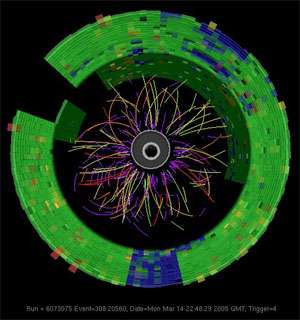Detecting the Traces of Mystery Matter

Using high-speed collisions between gold atoms, scientists think they have re-created one of the most mysterious forms of matter in the universe -- quark-gluon plasma. This form of matter was present during the first microsecond of the Big Bang and may still exist at the cores of dense, distant stars.
Image: A splash of subatomic particles is created by the collision of gold atom nuclei traveling at nearly the speed of light in Brookhaven National Laboratory's Relativistic Heavy Ion Collider. (Brookhaven National Laboratory/STAR Collaboration/courtesy graph)
UC Davis physics professor Daniel Cebra is one of 543 collaborators on the research. His main role was building the electronic listening devices that collect information about the collisions, a job he compared to "troubleshooting 120,000 stereo systems."
Now, using those detectors, "we look for trends in what happened during the collision to learn what the quark-gluon plasma is like," he said.
"We have been trying to melt neutrons and protons, the building blocks of atomic nuclei, into their constituent quarks and gluons," Cebra said. "We needed a lot of heat, pressure and energy, all localized in a small space."
The scientists produced the right conditions with head-on collisions between the nuclei of gold atoms. The resulting quark-gluon plasma lasted an extremely short time -- less than 10-20 seconds, Cebra said. But the collision left tracings that the scientists could measure.
"Our work is like accident reconstruction," Cebra said. "We see fragments coming out of a collision, and we construct that information back to very small points."
Quark-gluon plasma was expected to behave like a gas, but the data shows a more liquid-like substance. The plasma is less compressible than expected, which means that it may be able to support the cores of very dense stars.
"If a neutron star gets large and dense enough, it may go through a quark phase, or it may just collapse into a black hole," Cebra said. "To support a quark star, the quark-gluon plasma would need rigidity. We now expect there to be quark stars, but they will be hard to study. If they exist, they're semi-infinitely far away."
The project is led by Brookhaven National Laboratory and Lawrence Berkeley National Laboratory, with collaborators at 52 institutions worldwide. The work was done in Brookhaven's Relativistic Heavy Ion Collider (RHIC).
Source: UC Davis


















